[NOTE: Anyone interested in participating in this project is encouraged to contact our Wetlands Chair or our Board using the Contact Us menu above]
The North San Pedro Road (NSPR) corridor is our residents’ primary “lifeline” for evacuation and emergency response should Point San Pedro Road (PSPR) become inaccessible as it did the night of November 20. Unfortunately, the degradation of NSPR is a serious safety issue and threatens the preservation of the China Camp wetlands. The road also floods increasingly more regularly and at higher levels making it impassable. On December 13, County Supervisor Damon Connolly convened a meeting of County, City, State, and Federal officials to begin exploring options to address this critical transportation artery. As a Coalition Board member, I was also present to represent the residents along PSPR.
The meeting was very well attended with broad representation from the county, city, state parks, Friends of China Camp, National Estuarine Research (NERR), MMWD, and state and federal permitting agencies. It was a packed house.
The meeting began with a presentation by Mike Vasey from NERR on wetlands, flooding (which will get worse and more frequent over time), degradation of the road, and ecological consequences. NERR has modeled expanded culverts and a causeway option and determined that both would successfully address tidal exchange needed to keep the “back” (internal) wetlands healthy. Mike said that the National Oceanic and Atmospheric Administration (NOAA) had collaborative grants available to help begin to tackle the issue. They would provide facilitators and some technical assistance in helping us engage all of the parties involved in crafting a solution. He plans to apply for a grant early next year and will ask us and others for letters of support as the grants are very competitive.
A safety prospective was provided by Brigadier Sinnott from the SRFD. He characterized NSPR as a “life line” for evacuation and emergency response. The road is the only access for emergency vehicles to downtown San Rafael if 101 were to be blocked, and the only access for us and NSPR residents should we have another incident like the one on Nov. 20 when cars were diverted to NSPR after all four lanes of PSPR were blocked. Those on NSPR would have the same issue if anything happened east of the Civic Center post office. Brigadier Sinnott’s concern is with the safety of the entire road, not just the areas that flood. At Damon’s request, I spoke about my personal experiences with the flooding and road safety issues.
A representative of the State Park Department provided his perspective. He stated that from their viewpoint, the Department would ideally like to remove the road so that there would be only one way in and out in order to collect more fees. That said, the Department wants a healthy marsh and understands the safety issues. They are willing to work with us as long as we can find a viable way to fund the costs.
A representative from Friends of China Camp (FCC) suggested that we look at identifying a short-term solution to fix/improve the existing culverts and install a signal system to notify the public of the flooded areas before they get to them. When drivers get to the flooded area, they need to make a choice to go back the way they came or risk going through the flood waters which is a very dangerous alternative.
A strategic discussion ensued about how to fund the project which could run upwards of $30-$40M. The project is multi-faceted (transportation, environmental, and flood prevention). Therefore we should look to create a fund from multiple sources. Multiple phases should also be considered moving from a short-term solution to next phases of adoption based on thresholds until the longer term solution is achieved. This methodology would ensure that the short-term solution would not impact the longer term solution. We must also assess the cost-benefit of the various alternatives, one of which is to explore relocating the road entirely to protect endangered species. Another area of consideration is improving parking facilities to eliminate encroachment on the marshes from parking on the side of the road. In any case, we need to build the community’s knowledge of the project’s benefits and lay the ground work for community collaboration.
Mike Vasey added that we need to better understand the ecology of the back side marshes as they differ significantly from the front side marshes in order to weigh our alternatives. This work is underway.
It was decided that we would begin to explore short-term solutions with representatives from all in attendance. Damon will also add a representative from the NSPR corridor, the Bicycle Coalition, County Parks, and our Coalition’s Wetlands Chair.
Kati Miller
Secretary
Coalition Board
